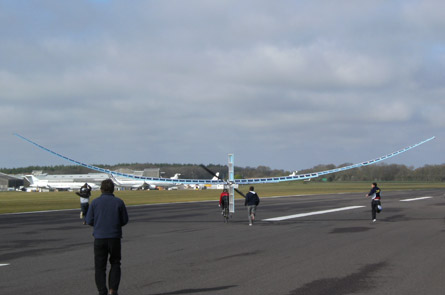Human-powered flight enthusiasts gained a lift last month when the Royal Aeronautical Society formally approved plans to hold a competition in July, two weeks ahead of the London Olympics.
And, with an eye on both the RAeS's Icarus Cup and bagging the society's last two unclaimed Kremer cash prizes for human powered flight, a Southampton University engineering department team got off the ground with a novel approach to developing a simple and robust machine suitable for competition in typical UK weather.
Icarus Cup organizer James Allen hopes to have about six teams at Lasham airfield, southwest of London near Alton, Hampshire, for the 13-22 July event. Each team will be allowed three pilots and be awarded performance points for challenges of accuracy, speed and endurance. Team prizes will be £2,000 ($3,250), £500 and £250, with the top-scoring pilot winning the Icarus Cup.
 |
|---|
© Southampton University The Southampton University bid uses a standard road racing bicycle as the drivetrain |
But as the nine-day format suggests, actual flying will be hostage to the weather. Human-powered aircraft to date - such as Paul MacCready's Gossamer Albatross, which captured a £100,000 Kremer prize for its 1979 crossing of the English Channel - have been flyable only in virtually still air. As Allen explains, the Icarus Cup concept is in part intended to encourage development of machines suitable for competitive flying in more normal conditions.
Also pushing in that direction are two as-yet unclaimed Kremer prizes together worth £150,000 for developing an aircraft suitable for short-course competition and for flying a marathon distance in less than an hour.
The Southampton University bid for these two prizes is based on two key innovations: an autopilot, and use of a standard road racing bicycle as the drivetrain.
Southampton University Human Powered Aircraft (SUHPA) project team leader Alex Forrester got off the ground at Lasham on 22 April (pictured), and although he failed to get properly airborne was left convinced that the concept is sound.
The wing provided enough lift to leave the runway at just 4.35kt (8.1km/h) ground speed, but the propeller needed more thrust to maintain altitude and SUHPA came right back down. Forrester reckons that problem can be resolved by increasing the available bicycle gear ratio to get more propeller speed at low ground speed.
Some mechanical adjustments also need to be made to the length of bicycle chain that connects the sprockets to the propeller, he adds, but a standard mountain bike chain tensioner and zip tie are encouraging potential solutions.
With another test flight of the 37-38kg (82-84lb) machine in mid-June before the Icarus Cup, Forrester hopes to be ready for a Kremer challenge later this summer.
Source: Flight International
















